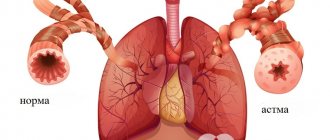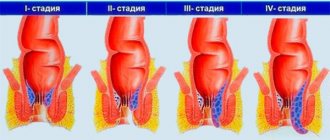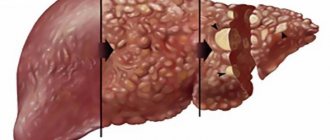Splenomegaly - what does it mean?
This term is used by doctors when the spleen has an abnormal increase in size. Often this disease occurs due to pathological processes in neighboring organs. The average weight of a healthy spleen does not exceed 150 grams. If during palpation or ultrasound the size of the spleen is more than 7 centimeters diagonally, an enlargement of the organ is recorded. But the increase itself is not an indicator of the disease.
Diagnosis of the disease occurs according to the following signs:
- The size of the spleen is significantly larger than normal.
- During palpation, the organ and its edges can be clearly felt.
- The spleen is motionless during breathing.
Splenomegaly is not a separate disease, but a symptom of a violation of one of the important processes . In this case, the functioning of the organ becomes unstable, and the spleen can begin to rid the body not only of dead blood cells, but also of active ones.
Doctors distinguish two types of spleen enlargement:
- Inflammatory - it manifests itself against the background of a heart attack, viral and bacterial infections, and an abscess.
- Non-inflammatory - such splenomegaly is observed in iron deficiency anemia, diabetes mellitus, rheumatism, polymyositis, gastrointestinal diseases, psoriasis.
Enlargement of the organ can be moderate when the length of the spleen reaches 20 cm, and severe if the organ is enlarged by more than 21 cm.
The mechanism of pathology development
The danger of hypersplenism lies in the insufficient performance of the spleen and liver of their functions. This is a potentially lethal syndrome, because the changes lead to a total decrease in immune defense and worsening inflammatory processes. It is important to promptly recognize the painful condition and begin therapy as early as possible.
Spleen with hypersplenism
The spleen is the largest lymphoid formation in the body and an important part of the immune system. The organ is located in the left upper abdomen, behind the lower ribs. The spleen traps and destroys old, misshapen red blood cells. The organ also performs an immune function. The spleen is needed to fight infections. A person can live without this organ, but the risk of serious illness increases.
The terms splenomegaly and hypersplenism come from the Latin name for the spleen, splen. The first means an increase in the size of the organ compared to the normal state, as a result of which the edge of the organ protrudes 2-3 cm from under the costal arch.
Hypersplenism is excessive activity of the spleen, which is accompanied by increased destruction of blood cellular elements and a decrease in their number. The syndrome may have a primary or secondary origin:
- Primary hypersplenism manifests itself as a disease of the spleen itself.
- Secondary hypersplenism develops against the background of chronic hepatitis and cirrhosis of the liver. Often the syndrome is accompanied by an enlarged spleen - splenomegaly.
Normally, the spleen produces new lymphocytes, serves as a “depot” for platelets, and promotes the “utilization” of only old and damaged red blood cells. When the liver is damaged, these functions are impaired. The production of leukocytes decreases, the process of producing red blood cells is disrupted - they begin to be actively destroyed.
Intrahepatic portal block
The pathology occurs due to stagnation of blood in the organ due to increased portal pressure. This leads to changes in the spleen, which are accompanied by a decrease in the number of circulating formed elements in the bloodstream. A compensatory reaction is triggered in the bone marrow - proliferation and formation of new blood cells increase.
With hypersplenism, blood cells do not have time to “grow old” and become damaged, but are already destroyed. At the same time, bone marrow hematopoiesis is inhibited.
According to researchers, it is the spleen that secretes hormones that regulate the functions of the bone marrow.
The mechanism of excessive destruction of blood cells is activated, but a sufficient number of cells are not produced to replace the “deleted” ones. Pancytopenia occurs - a combination of anemia, leukopenia and thrombocytopenia. This is a deficiency in the peripheral blood of erythrocytes, leukocytes and platelets.
Splenomegaly: causes
The success of treating splenomegaly largely depends on how correctly the cause of the pathology was diagnosed. An enlarged spleen can be caused by bacterial, viral, protozoal infections, helminths, and pathologies of other organs and systems.
The main bacterial and viral infections that cause splenomegaly are:
- Splenic tuberculosis - it has scanty clinical symptoms and can be detected as a result of a cytological examination.
- Brucellosis is a dangerous infection that affects not only the spleen, but also the heart, blood vessels, musculoskeletal system, genitourinary and nervous systems.
- Viral hepatitis is one of the most common infections that affects the spleen, liver and bile ducts.
- Rubella - the disease causes splenomegaly, and can also cause the development of diabetes mellitus and panencephalitis.
- Syphilis - affects internal organs and causes inflammation of the lymph nodes. Treatment is directed to the main focus of the pathology.
The following may be protozoal infections that provoke splenomegaly:
- Malaria is an infectious disease often found in tropical countries. The infection spreads quickly and affects important organs such as the heart, kidneys, liver, and spleen.
- Toxoplasmosis is a dangerous infection, manifested by severe intoxication of the body and damage to the lymphatic and nervous systems.
- Leishmania is an infectious disease in which the spleen enlarges over the entire area of the left side of the abdominal cavity. The pathology is extremely dangerous, as it progresses quickly and spreads large ulcers over the skin.
Helminthiases leading to splenomegaly:
- Schistosomiasis - it is caused by blood-sucking organisms that penetrate the skin and affect the spleen, intestines, and genitourinary organs. The disease occurs in Asian and Middle Eastern countries.
- Echinococcosis is a parasitic infection that is widespread throughout the world. The disease affects the functioning of all organs and systems, which is manifested by such signs as severe intoxication, sharp pain in the abdomen, and chronic inflammation.
Autoimmune diseases as causes of splenomegaly:
- Rheumatoid arthritis is a common disease that affects the connective tissues and linings of the joints.
- Lupus erythematosus is a dangerous and common pathological process that disrupts the functioning of the immune system; it can affect internal organs, connective tissues and even the skin.
It is also worth noting that splenomegaly often occurs against the background of such serious diseases as cirrhosis of the liver, malignant tumors, and blockages of the vascular bed . Therefore, if the therapist has identified an enlarged spleen, it is necessary to undergo a full examination of the body and find the true cause of splenomegaly.
Symptoms of splenomegaly
The clinical picture of the disease is ambiguous, since the symptoms differ according to the form of the primary disease. However, this disease also has similar manifestations that make it possible to suspect a pathology of the spleen.
The inflammatory form is manifested by fever, intoxication, pain in the left abdominal region, rarely vomiting and diarrhea.
The non-inflammatory form is characterized by a mild, nagging pain syndrome, the temperature is often within normal limits, and the patient has no special complaints.
Please note: an inflamed spleen makes itself felt with characteristic signs quite rarely. Splenomegaly is often asymptomatic and is diagnosed together with the primary disease.
Discomfortable sensations are nonspecific; they are often attributed by patients to other pathological manifestations. And since the spleen is located next to the stomach, increasing in size, it begins to put pressure on the walls of the stomach, causing feelings of heaviness and fullness.
Common characteristics of inflammation also include pale skin, dark circles under the eyes, night sweats and weight loss. Occasionally, fever caused by body hyperthermia is observed.
External manifestations of the disease
Citizens often ask the question: with liver cirrhosis, what symptoms can be detected externally? How does the disease manifest itself in other organs? There are a number of signs by which the early stage of the disease can be diagnosed:
- Nails - with metabolic disorders, the nail plates become brittle and fragile. There is a slowdown in nail growth. Uncharacteristic white spots and stripes appear (Mückle lines). The nails are divided into 2 halves: a dark lower part and a light upper part.
- Swelling of the legs. The limbs are constantly filled with fluid, which increases daily.
- Eyes. The sclera gradually acquires a yellow tint (with biliary disorder).
- Ascites. Fluid accumulates in the abdominal cavity, and it is difficult to remove.
- The tongue becomes dry and purplish-red, later the color changes to purple.
Any suspicion of a disease should be checked in the clinic, a series of tests and biochemical diagnostics should be carried out. The advanced form is practically impossible to cure.
Diagnosis of splenomegaly
At the initial stage, the diagnosis of splenomegaly is carried out by a therapist who feels the abdomen by palpation. Next, the specialist collects an anamnesis of previous diseases and determines the presence of chronic diseases. It is clarified what the patient ate the day before and whether he visited tropical countries.
For a more accurate diagnosis, a number of laboratory tests are prescribed:
General stool analysis.
- A urine test that will show the condition of the genitourinary system.
- A biochemical test of blood from a vein, which can be used to determine the pathology of the liver and pancreas.
- Complete blood count for leukocytes and hemoglobin.
- Ultrasound of internal organs.
- Biological markers for the presence of autoimmune diseases.
- Computed tomography for a more detailed study.
If these results are not enough for diagnosis, a sternal puncture may be prescribed, which involves taking bone marrow and examining it for the presence of malignant tumors. After all the results are collected, the specialist prescribes drug treatment, and in especially severe cases, sends for surgical removal of the spleen.
The spleen is a hematopoietic organ, so if you have splenomegaly, you cannot do without a visit to a hematologist. In some cases, consultation with a rheumatologist, infectious disease specialist, or endocrinologist may be necessary.
Treatment of splenic splenomegaly
The choice of treatment method depends on how the primary disease was identified.
Please note: the enlarged spleen itself is treated only with the development of severe hypersplenism. Most often, the size of the organ returns to normal after the cause that caused the splenomegaly is eliminated.
Depending on the development of a particular underlying cause disease, the following therapeutic measures can be selected:
- If the cause of splenomegaly is bacterial infections, a course of antibiotics and probiotics is prescribed.
- In the case of helminthic infection, anti-cestodal, anti-trematodal or anti-nematodal drugs are prescribed.
- If the enlargement of the spleen is caused by viral diseases, antiviral drug therapy with immunomodulators is recommended.
- In case of vitamin deficiency, a multivitamin complex is prescribed and a balanced diet is prescribed.
To improve the patient's condition with splenomegaly, the following can be done:
- treatment with hormonal drugs;
- transfusion of leukocyte and platelet mass.
If conservative treatment does not produce positive results, and the spleen continues to enlarge despite the healing of the underlying cause of the pathology, removal of the organ is prescribed. Thus, doctors try to save the patient’s life and avoid such serious complications as organ rupture, anemia, complications of primary pathologies.
After removal of the spleen, a person’s immunity weakens, and resistance to numerous infections and viruses decreases. Therefore, the patient is prescribed a course of antibiotics after surgery and is offered to undergo immunization against dangerous infections.
Forecasting and warning
Splenomegaly is a sign of serious diseases that requires careful diagnosis and adequate therapy. The prognosis of the syndrome depends on the causative pathology. Due to the multifactor nature of this condition, it is difficult to draw any conclusions regarding future prospects.
Specific prevention that can protect a person from splenomegaly has not currently been developed. General preventive measures are aimed at preventing the development of diseases that can lead to sudden enlargement of the organ. To do this, it is necessary to undergo an annual medical examination, promptly identify and treat infectious diseases and other pathological processes, sanitize inflammatory foci, strengthen the immune system, lead a healthy and active lifestyle without nicotine and alcohol, and get vaccinated in accordance with the National Calendar.
Splenomegaly is a serious process, but not as dangerous as its underlying disease. Modern medicine knows of cases where the size of the spleen returned to normal after adequate complex therapy for the causative pathology.
Prevention of splenomegaly
Preventive measures that will help avoid inflammation of the spleen and preserve the functioning of the organ are quite simple and accessible. First of all, you need to give up bad habits, strengthen the body’s defenses, carry out timely vaccinations, especially when traveling frequently, and follow simple hygiene rules.
Regular examinations of the body, treatment of chronic and acute diseases, seeking medical help for alarming symptoms, hardening, moderate physical activity, and walks in the fresh air will help prevent the serious development of the disease.
It is worth noting that splenomegaly itself is not particularly dangerous. The greatest danger is posed by the primary disease, which affects not only the spleen, but also other organs. Therefore, with timely seeking help and combined treatment, splenomegaly can be stopped and complications can be prevented.
Chumachenko Olga, medical observer
16, total, today
( 40 votes, average: 4.88 out of 5)
Radiation colitis: causes, symptoms, treatment
Pain in the right hypochondrium - possible causes
Related Posts
Complications
As liver damage progresses, people with primary biliary cirrhosis may develop a range of severe problems, including:
Cirrhosis. Cirrhosis is scarring of the liver that makes it difficult to function. Cirrhosis can develop in the later stages of primary biliary cirrhosis. Continued cirrhosis can lead to liver failure, in which the liver is no longer able to function properly. Increased pressure in the portal vein (portal hypertension). Blood from the intestinal tract, spleen and pancreas enters the liver through a large blood vessel called the portal vein. When scar tissue blocks the normal blood supply to the liver, blood flows back, like water behind a dam, causing increased pressure in the vein. Because blood does not pass through the liver, hormones, drugs, and other toxins are not filtered out of the bloodstream properly. Dilation of blood vessels (varicose veins). Blood circulation through the portal vein is slowed or blocked, and blood may flow back into other veins, mainly the veins of the stomach and esophagus. The walls of blood vessels become thinner, and increased pressure in the veins can cause bleeding in the upper stomach or esophagus. Bleeding is a medical emergency that requires immediate medical attention. Liver cancer. The destruction of healthy liver tissue in cirrhosis increases the risk of developing liver cancer. Weakened bone tissue (osteoporosis) Primary biliary cirrhosis increases the risk of weak and brittle bones, making them more susceptible to fractures. Vitamin deficiency Lack of bile impairs the ability of the digestive system to absorb fats and fat-soluble vitamins: A , D, E and K. In advanced cases of primary biliary cirrhosis, this can lead to vitamin deficiency. Memory impairment. Some people with primary biliary cirrhosis have problems with memory and concentration. An increased risk of developing another disease. In addition to damage to the bile ducts and liver, people with primary biliary cirrhosis have metabolic and immune disorders, including thyroid disorders, limited scleroderma (CREST syndrome) and rheumatoid arthritis.











